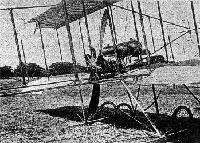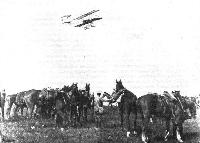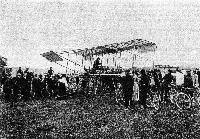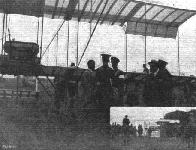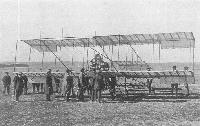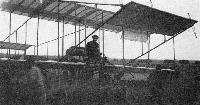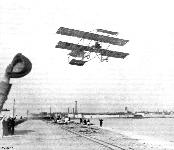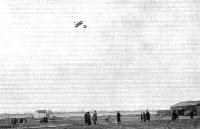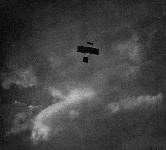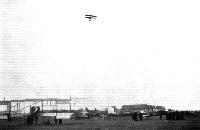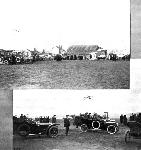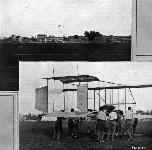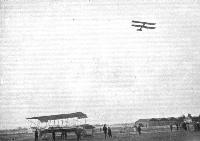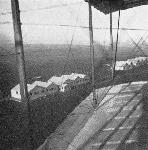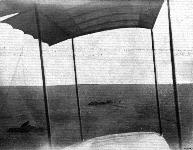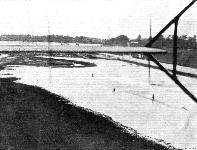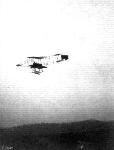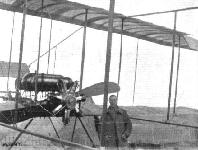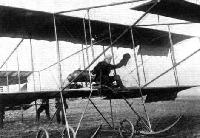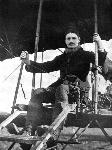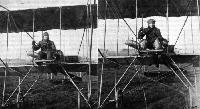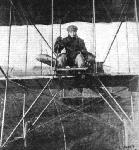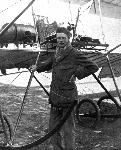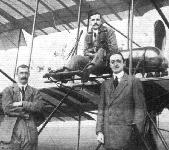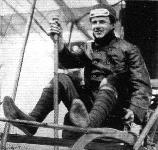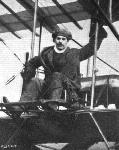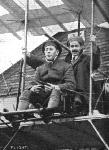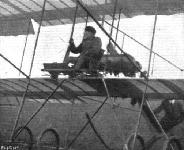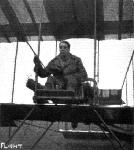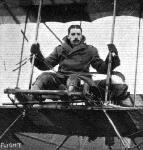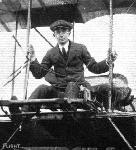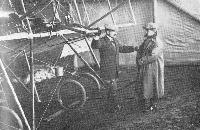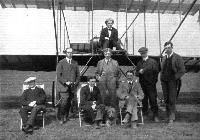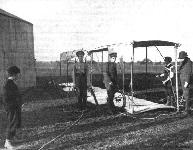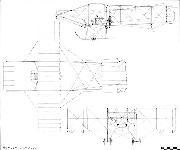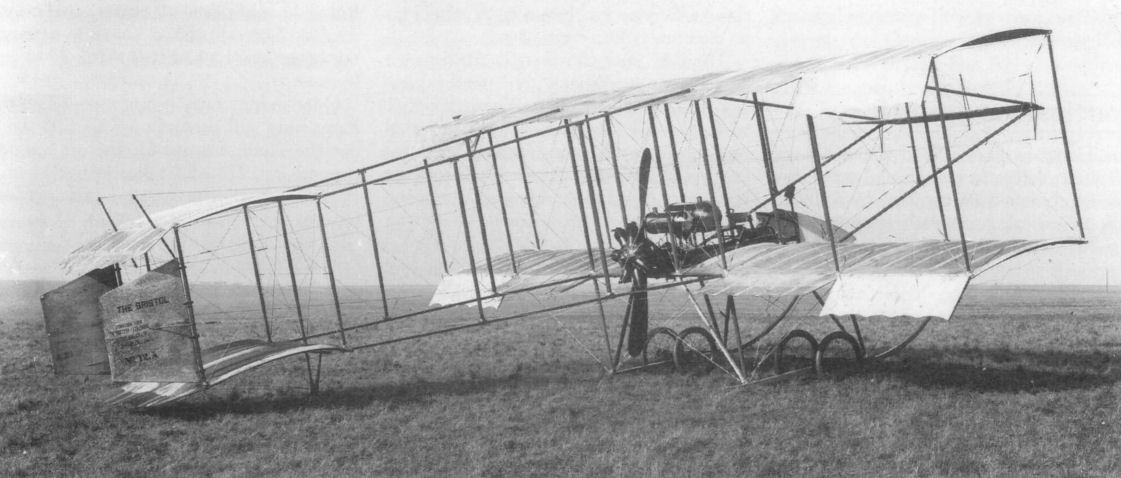
Описание
Страна: Великобритания
Год: 1910
.
Варианты
- Bristol - Boxkite - 1910 - Великобритания
- Bristol - Military type - 1911 - Великобритания
- C.Barnes Bristol Aircraft since 1910 (Putnam)
- M.Goodall, A.Tagg British Aircraft before the Great War (Schiffer)
- J.Bruce British Aeroplanes 1914-1918 (Putnam)
- P.Lewis British Aircraft 1809-1914 (Putnam)
- Журнал Flight
-
K.Delve - World War One in the Air /Crowood/
Bristol Standard Boxkite No. 12a.
The basic nature of aeroplane design is evident in this Bristol Boxkite. The first powered aeroplane flight had taken place in 1903 but in the absence of military interest (and therefore investment) development was slow and left to private venture. -
P.Jarrett - Pioneer Aircraft: Early Aviation Before 1914 /Putnam/
The other engine that did so much to advance the aeroplane's development was the 50hp Gnome rotary, seen here installed on Bristol Boxkite No 10 in May 1911, during demonstration flights in Australia.
-
Журнал - Flight за 1910 г.
Getting the Bristol biplane of the British and Colonial Aeroplane Co. ready for M. Edmonds, who is in charge of this machine, at the Lanark Flight Meeting.
-
Журнал - Flight за 1910 г.
A British-built "Bristol" biplane in flight on Salisbury Plain, piloted by Edmond. This machine was built entirely at their Filton works, near Bristol, by the British and Colonial Aeroplane Co., of which Sir George White, Bart., is a director. Needless to say, it has aroused considerable interest at the Company's flying school on Salisbury Plain, where Edmond has, we understand, been very successful in carrying passengers with it. This type of machine is now being turned out as rapidly as possible, and the Company's proficiency may be judged from the fact that the machine is seen in flight above the very first day it was erected.
-
Журнал - Flight за 1910 г.
DURING THE BRITISH ARMY MANOEUVRES. - Captain Dickson, on his biplane, reconnoitring over the Somerset Yeomanry.
-
Журнал - Flight за 1910 г.
DURING THE BRITISH ARMY MANOEUVRES. - Captain Dickson's aeroplane retaken by the "Reds."
-
P.Jarrett - Pioneer Aircraft: Early Aviation Before 1914 /Putnam/
Captain Bertram Dickson prepares to fly his Bristol Boxkite during the British Army maneouvres on Salisbury Plain in September 1910.
-
Журнал - Flight за 1910 г.
ON WYLYE DOWN IN THE EARLY MORNING MISTS DURING THE BRITISH ARMY MANOEUVRES. - Guarding Captain Dickson's biplane in Camp.
-
Журнал - Flight за 1910 г.
Capt. Dickson, at the British Army manoeuvres, with his British-built "Bristol" biplane, in consultation with some of the officers. Inset below is a general view of the "Bristol" machine in charge of the cavalry.
-
C.Barnes - Bristol Aircraft since 1910 /Putnam/
Boxkite No.8 (50 hp E.N.V.) at Larkhill in November 1910.
-
Журнал - Flight за 1911 г.
Mr Collyns Pizey just about to start off from Salisbury Plain for Brighton with the Bristol biplane for Mr. O. C. Morlson, as described in our last issue. Mr. Fleming is in the foreground, and on the extreme right M. Vusepey. In the right-hand photograph are Mr. Hotchkiss, sitting at wheel of car, and Mr. Fleming, standing, who followed Mr. Pizey to Brighton by road.
-
M.Goodall, A.Tagg - British Aircraft before the Great War /Schiffer/
Bristol Boxkite with Gnome rotary engine. The majority built were of similar type.
-
Журнал - Flight за 1911 г.
Mr. E. Howard Pixton and his "Bristol" biplane, which he recently flew from Amesbury to Hayling Island, where he subsequently made some flights under the somewhat trying conditions of the gales which have been blowing in that district. The left-hand view shows the machine just starting for a flight in front of the Royal Hotel, with Lieut. Burney, R.N., and Mr. Farnall Thurston, of the Bristol firm, as passengers. The float under the seat should be noted, which is provided in case the machine should descend into the sea. The right-hand view shows the machine "camped" out for the night between a house and some bathing machines.
-
C.Barnes - Bristol Aircraft since 1910 /Putnam/
Edmond on Boxkite No.7 at Larkhill on 30 July 1910.
-
Журнал - Flight за 1911 г.
Mr. Low just "off" on his Bristol biplane at Brooklands Aerodrome.
-
Журнал - Flight за 1911 г.
STARTING FOR THE BRIGHTON RACE. - D. Graham Gilmour taking-off at Brooklands in the Bristol Boxkite No. 31 on 6 May, 1911, in the race to Brighton in which he came second.
-
Журнал - Flight за 1911 г.
OVER PORTSMOUTH BY AEROPLANE. - The somewhat suggestive photograph of a trip taken some little time ago by Mr. Graham Gilmour on a Bristol biplane, after having "shelled" Fort Blockhouse, when flying to Portsmouth a few days before. In our picture Mr. Gilmour is seen flying from the Haslar sea wall - a difficult rising ground by reason of the telegraph wires and other obstructions on the ground - out to sea on his way to Brighton.
-
C.Barnes - Bristol Aircraft since 1910 /Putnam/
Edmond flying Boxkite No.7 at Lanark in August 1910.
-
Журнал - Flight за 1910 г.
FLYING OVER THE AVON GORGE. - Monsieur Tetard flying a "Bristol" biplane over the Avon Gorge recently, as reported in these pages.
-
Журнал - Flight за 1911 г.
Mr. Graham Gilmour giving an exhibition flight at Brooklands on the Bristol biplane last Saturday by way of gratifying the disappointed visitors who had foregathered to witness the start for the Brighton flight. At the time a very high wind, amounting almost to a gale, was blowing.
-
Журнал - Flight за 1911 г.
BROOKLANDS TO BRIGHTON RACE. - Graham Gilmour well up over Brooklands for the Brighton Race.
-
Журнал - Flight за 1911 г.
FLIGHT IN AUSTRALIA. - From New South Wales, Mr. A. H. Wakeford sends us the above interesting photographs of Mr. J. Hammond flying on his Bristol biplane at Ascot, Sydney, on May 5th last. On the left Hammond is crossing the main road during a trial spin, and on the right he is finishing the day with a high flight as the sun is setting.
-
Журнал - Flight за 1911 г.
IN THE CLOUDS. - A snapshot of Mr. H. M. Maitland flying over Salisbury Plain recently, the day before he had the accident which has temporarily taken him out of the aviators on the active list.
-
Журнал - Flight за 1911 г.
FLYING OVER SALISBURY PLAIN. - M. Maurice Tetard and Mr. A. R. Low flying their Bristol biplanes over Salisbury Plain. The photograph was taken while M. Tetard (on the right) was ascending for an altitude flight. On the left is the Bristol military type machine with the extended upper plane. The illustration affords an excellent comparison of the two types of machine in flight.
Другие самолёты на фотографии: Bristol Military type - Великобритания - 1911
-
Журнал - Flight за 1911 г.
Mr. Low, on his Bristol biplane, getting well into the air at Brooklands. At rest are Mr. Sopwlth's Howard Wright biplane, and in the distance the Hanriot monoplane.
Другие самолёты на фотографии: Hanriot monoplane - Франция - 1910Howard Wright No.2 biplane - Великобритания - 1910
-
Журнал - Flight за 1911 г.
CARS AND FLYING AT BROOKLANDS. - Brooklands has now become quite a centre of activity by reason of the flying attractions daily in operation there. Two pictures, taken on Saturday last, above give some idea of the gatherings which assemble day by day around the actual flying village. In the upper photograph Mr. Tom Sopwith is flying his E.N.V.-engined Howard Wright biplane, one of the very successful Bristol machines being seen to the right. In the bottom picture Mr. Low, one of the expert pilots of the Bristol Co., is making one of his fine flights round the aerodrome.
Другие самолёты на фотографии: Howard Wright No.2 biplane - Великобритания - 1910
-
Журнал - Flight за 1911 г.
AVIATION IN SINGAPORE. - Scene during the aviation meeting organised there in March. The photographs show Mr. Joseph Christiaens in full flight on a "Bristol" biplane, and below, his machine being wheeled out ready for "taking off."
-
Журнал - Flight за 1911 г.
FLYING AT BROOKLANDS ON EASTER MONDAY. - In spite of the high wind whteh prevailed at Brooklands, Mr. Pixton, on the Roe biplane, put up a good flight for the Endurance Prize, securing it with 1h. 27m. 32s. In our photograph Mr. Pixton is seen during this flight, the machine on terra firma being one of the famous Bristol biplanes.
Другие самолёты на фотографии: Avro Type D - Великобритания - 1911
-
C.Barnes - Bristol Aircraft since 1910 /Putnam/
Larkhill Flying School photographed from a Boxkite by Stanley White in 1911.
-
Журнал - Flight за 1911 г.
AEROPLANES AND THE BRITISH ARMY. - Another photograph secured from Lieut. Barrington Kennett's biplane last week at Salisbury Plain in the early morning. In this some of the cavalry will be seen in the centre of the picture, and, away beyond on the horizon, the regiment is seen in full strength stretching across the plain.
-
Журнал - Flight за 1911 г.
AEROPLANES AND THE BRITISH ARMY. - A general view of Hamilton Camp, Salisbury Plain, where the 4th Cavalry Brigade are encamped in readiness for the divisional training. This picture was secured on Thursday morning of last week, at reveille, from the biplane of Lieut. Barrington Kennett, who has been putting up such splendid flying work recently. Note the shadow of the biplane in the extreme foreground.
-
Журнал - Flight за 1912 г.
A view of Brooklands during the skating spell which has been in force recently, showing the flooded meadows reaching right up to the paddock sheds. This picture was taken from Pizey's Bristol biplane last week.
-
Журнал - Flight за 1911 г.
STONEHENGE AS SEEN FROM A BRISTOL AEROPLANE. - This is, we believe, the first photograph of this ancient landmark as seen from above. It was secured at 5 a.m. by a member of FLIGHT staff when flying with Mr. C. P. Pizey on a Bristol biplane last week.
-
Журнал - Flight за 1911 г.
A new view of Stonehenge, taken from Mr. H. Busteed's "Bristol" biplane, by Mr. Dacre, a pupil, when flying as passenger.
-
Журнал - Flight за 1912 г.
FROM TERRA FIRMA AND FROM ON HIGH. - The "Bristol" aviation schools at Salisbury Plain, with a Bristol two-seater monoplane in flight; and inset is a view of the same scene from a Bristol biplane.
Другие самолёты на фотографии: Bristol Prier monoplane / P-1 - Великобритания - 1911
-
Журнал - Flight за 1913 г.
Mr. F. Warren Merriam, with Lieut. Picton Warlow - a pupil - as passenger, making a flight in one of the Bristol biplanes at Brooklands. Mr. Merriam is descending from 2,000 ft. with engine off, the propeller, it will be noted, having stopped.
-
Журнал - Flight за 1912 г.
Pizey, of the Bristol School at Brooklands, making a clean landing after a tuition flight with a pupil.
-
Журнал - Flight за 1912 г.
The two photos sent by Mr. G. W. Whatmore, showing Mr. Hammond just alighting on his machine, and ready to start with Mrs. Hammond, the first occasion of a lady passenger being carried in Australia.
-
Журнал - Flight за 1912 г.
Lieut. H. H.Harford's Bristol biplane at Peshawur, in India. Lieut. Harford's mechanic is standing by the machine.
-
Журнал - Flight за 1910 г.
AVIATION ON SALISBURY PLAIN. - The school buildings of the British and Colonial Aeroplane Co., Ltd., the builders of the "Bristol" aeroplane, with which Capt. Bertram Dickson, during the recent Army manoeuvres, carried out some fine flights.
-
Журнал - Flight за 1911 г.
AVIATION AT THE FRENCH ARMY MANOEUVRES. - Some of the Bessonneau hangars at Vesoul, and the military aeroplanes which are giving such a splendid account of themselves.
Другие самолёты на фотографии: Bleriot Bleriot-XI-2 - Франция - 1911Breguet 3 - Франция - 1910
-
Журнал - Flight за 1911 г.
Mr. H J. Thomas, nephew of Sir George White, the head of the enterprising British and Colonial Aeroplane Company of Bristol, about to commence a flight on one of the Bristol machines. Mr. Thomas has the proud distinction of being the youngest certificated aviation pilot in Great Britain.
-
Журнал - Flight за 1911 г.
LIEUT. D. G. CONNER, R.F.A.
-
Журнал - Flight за 1911 г.
TWO OF THE FLYERS ON BRISTOL BIPLANES AT SALISBURY PLAIN. - On the left Mr. R. W. Philpott, and on the right Mr. E. Hotchkiss, who took his brevet on Tuesday, he being the ninth Bristol pupil to secure his certificate during the last three weeks.
-
Журнал - Flight за 1912 г.
Second Lieut. Hotchkiss who was killed in company with Lieut. Bettington on Tuesday.
-
Журнал - Flight за 1911 г.
Brigadier-General David Henderson, pupil of the British and Colonial School at Brooklands, who took his flying brevet last week.
-
Журнал - Flight за 1911 г.
LIEUT. B. H. BARRINGTON KENNETT. One of the most prominent aviators in the British Army.
-
Журнал - Flight за 1911 г.
AT THE BROOKLANDS "BRISTOL" SCHOOL. - In the pilot's seat Lieut. Harford, on the left Capt. Harrison, and on the right Mr. Fleming of the Bristol Co.
-
Журнал - Flight за 1912 г.
W. E. Hart, the Australian aviator who recently made a flight of 47 miles from Penrith to Sydney, accomplishing the distance in 55 mins.
-
Журнал - Flight за 1912 г.
Mr. F. Warren Merriam, who has just obtained his brevet on a Bristol biplane at Brooklands.
-
Журнал - Flight за 1912 г.
Mr. J. J. Hammond, the Australian aviation pioneer.
-
Журнал - Flight за 1912 г.
Mr. Fielding, another pilot who has just obtained his brevet on a Bristol biplane at Brookiands.
-
Журнал - Flight за 1912 г.
Lieut. Longcroft, an old pupil of the Bristol School, at the control of one of that school's biplanes.
-
Журнал - Flight за 1912 г.
Mr. Collyns Pizey, of the Brookiands Bristol School, and his cousin, Mr. C. H. Pizey, in the passenger's seat.
-
Журнал - Flight за 1912 г.
C. Lindsay-Campbell starting for his brevet altitude test on a Bristol biplane at Salisbury Plain.
-
Журнал - Flight за 1913 г.
Lieut. E. Peirse, R.N.R., one of the recent successful pupils for his brevet at the Bristol Flying School at Brooklands.
-
Журнал - Flight за 1913 г.
Lieut. M. R. Chidson, R.G.A., one of the recent Bristol pupils at Lark Hill to secure his R.Ae.C. certificate.
-
Журнал - Flight за 1913 г.
Mr. H. C. Tower who took his brevet at the Bristol School, Salisbury Plain on April 23rd, when he made an excellent flight at 500 ft high.
-
C.Barnes - Bristol Aircraft since 1910 /Putnam/
Henri Jullerot and Stanley White at Durdham Down, 14 November 1910.
-
C.Barnes - Bristol Aircraft since 1910 /Putnam/
Pioneers in the field: Edmond in Boxkite No.8 at Lanark in August 1910, with (l. to r.) Crisp, Frank Coles, Lesue Macdonald, Collyns Pizey, G. H. Challenger, Bendall and Briginshaw.
-
Журнал - Flight за 1912 г.
AT THE BRISTOL FLYING SCHOOL AT BROOKLANDS. - Some aviators and pupils. From left to right, top row Lieut. Smith, Mr. Collyns Pizey, head of the Bristol School at Brooklands, Mr. Carfrae, and Mr. Lane. In the bottom row Mr. Merriman, and Capt. Weeding are standing to the right of the picture.
-
Журнал - Flight за 1912 г.
AT BROOKLANDS AERODROME - A FEW PUPILS AT THE BRISTOL SCHOOL. - Reading from left; (top row) Mr. W. Bendall (instructor), Hon. Lieut. Boyle (passenger seat and who has just obtained his certificate), Capt. Pigot (in front seat, who has also just obtained his brevet), Mr. F. W. Merriam (chief instructor); (bottom row) Lieut. Empson, Major Forman, Lieut. Kitson, and Lieut. Rodwell.
-
Журнал - Flight за 1912 г.
ALL BRITSH. - A snap group at the Bristol School, Lark Hill, Salisbury Plain. From left to right (on the machine) : E. Harrison (pilot instructor, Australian), V. P. Taylor (recently passed pilot, Australian), Geoffrey England (pilot instructor, English). Standing: H. Busteed (pilot instructor, Australian), and C. P. Pizey (pilot instructor, the school manager, and Lieut. in the R.F.C.).
-
Журнал - Flight за 1913 г.
SOME AVIATORS AND PUPILS AT THE EASTBOURNE AERODROME. - From left to right: (seated) Messrs. H. Fill, F. Hucks, F. B. Fowler; (standing) B. Roberts, L. Fry, E. L. Gassier, W. Morkill, and in the pilot's seat, T. A. Rainey.
-
Журнал - Flight за 1910 г.
AFTER THE STORMS LAST WEEK. - Sorting out Mr. Greswell's aeroplane after the wreck of his hangar. Mr. Greswellt who had hoped to have started for the De Forest L4,000 Prize, is standing on the extreme right of the machine.
-
P.Jarrett - Pioneer Aircraft: Early Aviation Before 1914 /Putnam/
The wrekage of the Bristol Boxkite in which Captain Reynolds had his remarcable escape on 19 August 1911. He stood on the underside of the upper wing as the inverted aeroplane made its haphazard descent from 1,700ft, then jumped clear just before impact.
-
C.Barnes - Bristol Aircraft since 1910 /Putnam/
Bristol Standard Biplane (Boxkite)
-
P.Lewis - British Aircraft 1809-1914 /Putnam/
Bristol Boxkite
C.Barnes Bristol Aircraft since 1910 (Putnam)
The Bristol Boxkite
The Bristol biplane of 1910, familiarly but inaccurately dubbed 'the Boxkite', was an unashamed copy of the Henri Farman, using the same dimensions and scantlings, but introducing the more refined metal fittings, such as steel clips and cast aluminium strut sockets, of Zodiac practice. The quality of French-built Farmans was somewhat variable, but the Bristol biplane, though similar in general appearance, was equivalent to or better than the best that France had produced at that time. Indeed when the solicitors for Farman Freres proposed to sue the 'Bristol' Directors for infringement of patents, the Directors immediately entered a defence claiming substantial improvements, and no court proceedings ensued. The first two Boxkites were constructed at Filton to drawings made by George Challenger in June 1910, immediately after the abandonment of the Zodiac. They differed from all later Boxkites in having rear elevators with straight trailing edges and in having two, instead of one, intermediate vertical struts between each pair of upper and lower front booms. No. 7 was at first fitted with a 50 h.p. Gregoire four-cylinder engine and No.8 with a 50 h.p. eight-cylinder E.N.V., both being watercooled. A further point of difference was that No.8 had double-surfaced wings whereas No. 7 had a single fabric covering with pockets enclosing the ribs; the latter was standard Farman practice and was adopted on all later Bristol Boxkites, mainly to save weight. The Gregoire was unreliable and deficient in power, so Emile Stern's success in obtaining one of the first 50 h.p. Gnome rotaries released for export was particularly valuable. Fitted with this engine, No.7 was taken to Larkhill on 29 July 1910, assembled overnight, and flown the next day to a height of 150 ft. at the first attempt by Edmond, to the astonishment of beholders who had taken up prone positions on the ground in order to detect the first glimmer of daylight between the grass and the wheels.
With the efficiency of the design thus spectacularly confirmed, the two Boxkites were crated and dispatched to Lanark, where a six-day aviation meeting opened on 6 August at the race course. Only No.7 took part in any events, which Edmond completed without incident but with only one award, the second prize for the slowest lap, in which his speed was 45 m.p.h. Meanwhile, more Boxkites were laid down at Filton and Nos. 7 and 8 were allocated as initial equipment of the flying schools at Brooklands and Larkhill, respectively; No.8 retained the Lanark competition number 19 on its rudders for some months. As new aircraft were completed, the schools' complement was doubled, Larkhill receiving No. 9 in September and Brooklands No. 11 in November. Captain Dickson flew No.9 in the army autumn manceuvres in September and Lt. Loraine accompanied him on No.8, which had been equipped with a Thorne-Baker wireless transmitter. Nos. 10 and 12 were specially prepared for the Missions to Australia and India, respectively, the latter being the first to have upper wing extensions. The next two, Nos. 12A and 14 (No. 13 being unacceptable to any pilot of that date!) were flown from Durdham Down in the first public demonstration of the Company's activities; when these ended No. 12A was lent to Oscar Morison, who flew it in various demonstrations and competitions; No. 14 went on to Larkhill as a school aircraft, releasing No.9 for duty as the spare for the Indian Mission. Two further new Boxkites, Nos. 15 and 16, went to Brooklands, whence No. 11 was brought back for overhaul and packing as the spare for the Australian Mission. No. 16 was fitted with extended wings and a 60 h.p. E.N.V. water-cooled engine; the latter made it technically an 'All British' aeroplane for competition purposes, and thus it became the mount on which Howard Pixton, with Charles Briginshaw as mechanic, won the Manville Prize of ?500 for the highest aggregate time flown on nine specified days in 1911.
Both the Australian and Indian Missions arrived at their destinations in December, and on 6 January 1911 Jullerot demonstrated No. 12 before a Vice-regal party and a large crowd of spectators at the Calcutta Maidan. Invited to participate in the Deccan cavalry manceuvres, Jul1erot made several flights from Aurangabad, from 16 January onwards, carrying Capt. Sefton Brancker as army observer, and later took part in the Northern Manceuvres at Karghpur. Here conditions were very severe and both No. 12 and No.9 came to grief on the rock-strewn terrain, with a ground temperature of 100°F, but many flights were made and repairs kept pace with damage. When all the spares were used up, No. 9 was cannibalised to keep No. 12 flying and the latter survived to return to Larkhill as a school machine, being flown by many notable pupils, including Robert Smith-Barry, who was charged ?15 in October 1911 for repairs after a heavy landing on it.
In Australia, Hammond began flying on No. 10 at Perth late in December, going on to Melbourne, where 32 flights, many with passengers, were made. The Mission then moved to Sydney, whence Hammond went home to New Zealand leaving Macdonald as sole pilot. By 19 May 1911,72 flights totaling 765 miles had been completed without having had to replace a single bqlt or wire on No. 10. The spare machine, No. 11, still in its packing case, was sold to W. E. Hart, of Penrith, N.S.W., together with the unused spares, when the Mission left to return to England. Although this was the only direct sale made by both Missions, the Boxkite had by now begun to attract foreign buyers. The outcome of negotiations with the Russian Attache in Paris, William Rebikoff, was the first Government contract in the world for British aeroplanes, signed on 15 November 1910 for the supply of eight improved Boxkites having enlarged tanks and three rudders, which were called the Military model. The first three of these, Nos. 17, 18 and 19, were at first flown with 50 h.p. Gnomes, although 70 h.p. Gnomes had been specified for delivery in April 1911, when they were to become available. Meanwhile, No. 16, brought up to Military standard with three rudders but retaining its E.N.V. engine, was lent to Claude Grahame-White for an attempt to win the prize of ?4,000 offered by Baron de Forest for a flight from England to the most distant point along the Continental coast. No. 16 was damaged by a storm while waiting to take off from Swingate Downs, Dover, but was repaired in time for a second attempt on 18 December 1910, when Grahame-White was caught by a down-gust at the cliff-edge and crashed. No. 17, which was at Brooklands, was at once dispatched as a replacement, but caught fire soon after arrival at Dover, and Grahame-White then retired from the contest on his doctor's advice. Lt. Loraine had also entered the competition, flying No.8, but this too was badly damaged in the storm; No. 16 was eventually rebuilt and flown again at Brooklands. In April Nos. 18 and 19 were shipped to St. Petersburg together with Nos. 20 to 25 inclusive, after installation of 70 h.p. Gnome engines, but were later exchanged for two new machines, Nos. 26 and 30, in July 1911. No. 18 was damaged in transit back to Filton and written off, but No. 19 survived at Larkhill until May 1913, when it was dismantled and reconstructed as No. 134, which in turn was crashed at the Brooklands school in November 1913.
Still no contract came from the British War Office, and the next two Boxkites, Nos. 27 and 28, were standard school machines bought by the Belgian pilot Joseph Christiaens, who chose them for his flying displays in Malaya and South Africa. He took delivery of them on 19 January 1911, and after successful flights at Singapore on No. 27 went on to Cape Town and Pretoria, where he sold No. 28 to John Weston, who became the Company's agent in South Africa. A further school machine, No. 29, was sent to Brooklands in February 1911 and then two special exhibition models were built, having 70 h.p. Gnome engines, enclosed nacelles and increased span. The first, No. 31, was exhibited at Olympia in March 1911, and the second, No. 32, at St. Petersburg in April. The latter was inspected by the Czar and so impressed his military advisers that a gold medal and certificate of merit were awarded to the Company; and No. 32 was purchased in addition to the eight already ordered.
The War Office at last placed a contract, on 14 March 1911, for four Military Boxkites with 50 h.p. Gnomes as described in a specification submitted on 20 October 1910. Meanwhile Oscar Morison had damaged No. l2A while giving exhibition flights at Brighton, and No. 34 was taken from the production line to replace it. The first two War Office machines, Nos. 37 and 38, were delivered at Larkhill on 18 and 25 May, respectively, but then the War Office asked for the other two to be supplied with 60 h.p. Renault engines for comparison. This required a redesign of the engine mounting and carlingue, which resulted in a substantial nacelle structure in front of the pilot. No. 39, thus modified, was delivered at Larkhill on 9 July, by which time four more had been ordered, two with 50 h.p. Gnomes and two as spare airframes without engines. The latter (Nos. 40 and 41) were dispatched on 31 July, the second Renault machine (No. 42) on 2 August and the remaining Gnome machines (Nos. 48 and 49) during the subsequent fortnight. Nos. 43 and 47 were standard school Boxkites, the first being supplied to Larkhill while the second was taken to France by Versepuy when he returned in September 1911; he demonstrated it at Issy-les-Moulineaux and Vichy, where his mechanic was George Little; subsequently he sold it to the Bulgarian Government, to be flown by Lt. Loultchieff.
By this time the Boxkite production line had become well established and continued, mainly to supply wastage at the various schools, until 1914. In the standard models the wing extensions were retained but the third rudder was deleted. Strict interchangeability of components was maintained, and many later school machines incorporated serviceable parts from earlier aircraft. The 50 h.p. Gnome remained as the standard power unit except for No. 60 and No. 139, which had 70 h.p. Gnomes. The latter machine was supplied to R.N.A.S. Eastchurch in April 1913, receiving Naval serial no. 35, and was standard except for the engine, but No. 60 was similar to Nos. 31 and 32 with an enclosed nacelle, also incorporating longitudinal tanks and a push-pull handwheel control instead of the simple control-stick; this was demonstrated at Cuatros Vientos by Busteed in November 1911 and purchased soon afterwards by the Spanish Government, who ordered a similar spare airframe (No. 79) in which they fitted one of their own 70 h.p. Gnomes. Including rebuilds which received new sequence numbers, the total number of Boxkites built was 76, all at Filton except for the final six (Nos. 394-399), which were the first aeroplanes constructed at the Tramways Company's Brislington works. Although underpowered and out-dated at the end of their career, they survived mishandling often to the point of demolition, but the pupils emerged more or less unscathed and the mechanics performed daily miracles of reconstruction, so that school machines were constantly reappearing Phoenix-like from their own wreckage. Apart from the nine exported to Russia, three were sold to South Africa, two each to Australia, Germany and Spain, and one each to Bulgaria, India, Rumania and Sweden.
In addition to the Boxkite proper, there were two variants, both for competition work. The first of these was No. 44, which had wings of much reduced span and a small single-seat nacelle. This was for Maurice Tetard in the Circuit de l'Europe (racing no. 3) and was first flown on 30 May 1911; in the race it developed engine trouble and Tetard retired at Rheims, half-way through the first stage. The other was No. 69 and was a redesign in November 1911 by Gabriel Voisin using standard wings, but with the gap reduced and the front elevator and booms deleted; a single large tail plane and a single rudder replaced the normal biplane tail unit. It was sent to Larkhill for tests in February 1912. No photograph of this machine has survived and it was apparently soon rebuilt as a standard school Boxkite, in which form it was crashed at Larkhill by Major Forman on 3 November 1912.
SPECIFICATION AND DATA
Type: Bristol Biplane (Boxkite)
Manufacturers: The British & Colonial Aeroplane Co. Ltd., Filton and Brislington, Bristol
Power Plant:
One 50 hp Gregoire
One 50/60 hp E.N.V.
One 50 hp Gnome
One 60 hp Renault
One 70 hp Gnome
Model Standard Extended Racer Voisin
(Military) No. 44 No. 69
Span 34 ft 6 in 47 ft 8 in or 35 ft 32 ft 8 in
46 ft 6 in
Length 38 ft 6 in 38 ft 6 in 38 ft 30 ft 9 in
Height 11 ft 10 in 11 ft 10 in 11 ft 10 in 9 ft 6 in
Wing Area 457 sq ft 517 sq ft 350 sq ft 420 sq ft
Empty Weight 800 lb 900 lb 800 lb 800 lb
All-up Weight 1,050 lb 1,150 lb 1,000 lb 1,000 lb
Speed 40 mph 40 mph 50 mph 50 mph
Accommodation 2 2 1 2
Production 15 61 1 1
Sequence Nos. 7-11 12A 12 15-32 44 69
14 34 43 37-42 47
49 55 62 48 60 67
63 65 66 79 93 99
119 124-129
133-139 179
180 203
204 207
222 226
231 347
394-399
Описание:


